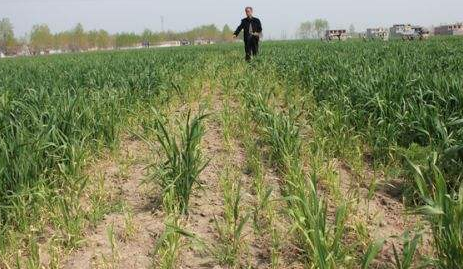Cause Analysis and Countermeasures of Dead Seedlings in Wheat Field
Winter wheat wintering dead seedlings occur year after year. However, the recent death of the wheat field in the province near the jointing stage is relatively rare. Since mid-March, the consultation has reflected the gradual increase of wintering dead seedlings. There are farmers in Shijiazhuang, Baoding and Zhangzhou, and the serious dead rate of the field accounts for 2/3.
First, the type of dead seedlings is empty hanging seedlings, such as Yucheng Zengcun, the wheat field has been watered for half a month after the spring, and found that the seedlings have no new roots, and began to die. Second, two species were planted in the same plot, one of which was dead, and the other Shixin 733 grew normally. The third is that the dead seedlings that have been poured with frozen water are not normal. The seedlings of the seedlings, the black roots and the yellow leaves of the heart, are still Shixin 733, which makes the farmers feel very strange. The fourth is to die after a turn of green, rotten roots, heart yellow. The occurrence of dead seedlings is more complicated.
Second, the cause analysis is mainly in several aspects. The first is related to planting. Due to continuous rains in the first ten days of last year, the planting was delayed. The seedlings are small, the points are less, and some of the fields are only wintering. Weak seedlings are the characteristics of this year's seedlings. The second is related to the winter sex of wheat. For example, wheat has selected varieties with weak winter and shallow tillers, and is vulnerable to the danger of large temperature difference. Therefore, when looking back at the green seedlings, it is already not strong. If you water it again in a drought or low temperature, you will die immediately. The third is related to the soil moisture at the time of sowing. Due to continuous precipitation, the soil moisture is large, which is conducive to the occurrence of soil-borne diseases, especially the re-watering of frozen water, and the humidity is suitable for the disease. In the early March monitoring survey, the incidence of root rot in spring this year was more common than in previous years. Statistics 4 out of 6 cities saw the disease. Among them, the rate of rickets was 1.3%, Xingtai was 3.95%, Hengshui was 0.27%, and Ganzhou was 0.05%. The disease of rotten roots should be root rot, which occurs as a distribution of pieces, and a serious dead seedling. The fourth is spring temperature and humidity. The temperature in this spring has been high and low, falling to 3 °C a few days ago, and the maximum temperature before cooling is 24 °C, weak wheat seedlings are inevitably injured. Since the spring, there have been many winds in our province, and most of the wheat areas have no precipitation. Farmers want to water, and they are afraid of the severe cold in recent years. Therefore, some weak fields that should be promoted early are not managed in time. There may be other reasons for the death of Miaotian, and specific to a certain plot may be triggered by several factors.

Third, according to the study, the rate of dead seedlings is less than 10%, but higher than 20% will result in reduced production. The rate of dead seedlings is 30% to 50%, and the yield is severely reduced. Farmers are requested to refer to the indicators and dispose of their own fields as appropriate. Countermeasures are as follows:
1. For the situation where the situation is not so heavy, Tian should strengthen the management of water and fertilizer, pay attention to the temperature change, and then water and fertilize continuously for a good day. Avoid significantly lowering ground temperature and affecting root systems.
2. For the field of root rot (or sheath blight) and empty hanging seedlings should be sprayed and combined to give fertilizer regulation, promote hair roots, restore growth, inhibit the spread of the disease.
Prevention and treatment prescription: love more than 6000 times liquid + 600 times liquid green wind 95+1% urea liquid + fungicide (acre with 15% powder rusting wettable powder 150 ~ 200 grams, or 50% carbendazim WP 500 grams, or 12.5 50% of the Hugoli WP, 50~70 kg of water) is sprayed on the base of the wheat stem, and the effect is better after 7 days.
Self Lock Plastic Pull Tight Seals
The Plastic Pull Tight Seals are adjustable length seals, have extra high strength with different lengths and they are designed for bag applications.
Applications: Bags (Mail, Canvas, Courier) etc.
The Plastic Pull Tight Seals featured with a flat wide strap or a round tail strap and a metal lock jaw. The material can be pp , pe , nylon etc.
The seals are easy to use, just a simple pull the seals are applied. The removal shall be with a cutter.
Standard Marking for the plastic pull tight seals are hot stamping, laser engraving etc.
Self Lock Plastic Pull Tight Seals,Plastic Pull Tight Seal,Plastic Pull Seal,Plastic Material Seals
Wenzhou Haoshi Light Industrial Products Co., LTD , https://www.economicseals.com